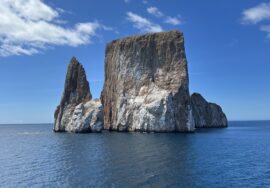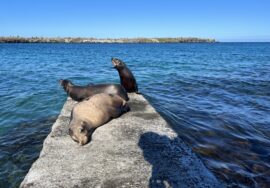
Ai Galapagos Research
The Impact of AI in Galapagos Research
The Galapagos Islands, located in the Pacific Ocean, are renowned for their unique and diverse ecosystem. These islands have long been a subject of scientific research, attracting scientists from around the world. In recent years, the use of artificial intelligence (AI) in Galapagos research has gained significant attention. AI has the potential to revolutionize the way scientists study and understand this delicate ecosystem, with its complex interactions and fragile balance.
One of the key areas where AI is making a significant impact is in the field of species identification. The Galapagos Islands are home to a wide variety of plant and animal species, many of which are found nowhere else on Earth. Traditionally, identifying these species has been a time-consuming and labor-intensive process. However, with the help of AI, scientists can now use image recognition algorithms to quickly and accurately identify different species. This not only saves time but also allows researchers to collect more data and gain a deeper understanding of the biodiversity in the Galapagos.
Another area where AI is proving invaluable is in the analysis of large datasets. The Galapagos Islands generate a vast amount of data, ranging from satellite imagery to climate data to genetic information. Analyzing this data manually would be a daunting task for any scientist. However, AI algorithms can process and analyze these datasets much faster and more efficiently than humans. This allows researchers to uncover patterns and trends that would otherwise go unnoticed, leading to new insights and discoveries.
AI is also being used to monitor and protect the fragile ecosystems of the Galapagos Islands. For example, drones equipped with AI algorithms can be used to survey and monitor the islands, providing real-time data on changes in vegetation, wildlife populations, and even illegal activities such as poaching. This data can then be used to inform conservation efforts and help protect the unique biodiversity of the Galapagos.
In addition to its practical applications, AI is also helping scientists in the Galapagos to better understand the complex ecological processes at play. By simulating these processes using AI models, researchers can gain insights into how different factors, such as climate change or invasive species, may impact the ecosystem. This knowledge can then be used to develop strategies for mitigating these impacts and preserving the delicate balance of the Galapagos.
While AI has the potential to revolutionize Galapagos research, it is important to approach its use with caution. The unique and fragile nature of the Galapagos ecosystem means that any interventions must be carefully considered and thoroughly tested. Additionally, the use of AI should always be complemented by traditional fieldwork and scientific observation to ensure accurate and reliable results.
In conclusion, the impact of AI in Galapagos research cannot be overstated. From species identification to data analysis to ecosystem monitoring, AI is revolutionizing the way scientists study and understand this unique ecosystem. By harnessing the power of AI, researchers are able to collect and analyze data more efficiently, leading to new insights and discoveries. However, it is important to approach the use of AI in Galapagos research with caution and to always complement it with traditional scientific methods. With the right balance, AI has the potential to greatly enhance our understanding of the Galapagos Islands and help us protect this fragile ecosystem for future generations.
Exploring the Role of AI in Conservation Efforts in the Galapagos Islands
The Galapagos Islands, located in the Pacific Ocean, are a unique and biodiverse ecosystem that has captured the attention of scientists and conservationists for decades. With its rich array of flora and fauna, the Galapagos Islands have become a living laboratory for studying evolution and the impact of human activities on fragile ecosystems. In recent years, there has been a growing interest in exploring the role of artificial intelligence (AI) in conservation efforts in the Galapagos Islands.
AI, with its ability to process large amounts of data and identify patterns, has the potential to revolutionize conservation efforts in the Galapagos Islands. One area where AI can make a significant impact is in monitoring and tracking endangered species. By using AI-powered drones and cameras, researchers can collect data on animal populations and their behavior, helping them better understand the threats they face and develop effective conservation strategies.
For example, AI can be used to analyze images and identify individual animals, such as the iconic Galapagos giant tortoise. By tracking the movements and behavior of these tortoises, researchers can gain insights into their habitat preferences and migration patterns. This information can then be used to design protected areas and implement measures to mitigate the impact of human activities on these vulnerable species.
AI can also play a crucial role in monitoring and managing invasive species in the Galapagos Islands. Invasive species, such as rats and feral cats, pose a significant threat to the native flora and fauna of the islands. Traditional methods of controlling invasive species, such as trapping and poisoning, can be time-consuming and have limited effectiveness. AI can help by analyzing data on the distribution and behavior of invasive species, allowing researchers to develop targeted and efficient control strategies.
Furthermore, AI can assist in the monitoring of marine ecosystems in the Galapagos Islands. The islands are home to a diverse range of marine species, including sharks, sea turtles, and marine iguanas. By analyzing data from underwater cameras and acoustic sensors, AI can help researchers track the movements and behavior of these species, providing valuable insights into their conservation needs.
In addition to monitoring and tracking, AI can also aid in the identification and classification of species in the Galapagos Islands. With its ability to analyze large datasets, AI can help researchers identify new species and understand the relationships between different species. This information is crucial for developing accurate biodiversity assessments and conservation plans.
While AI holds great promise for conservation efforts in the Galapagos Islands, it is important to recognize its limitations. AI is only as good as the data it is trained on, and in the case of the Galapagos Islands, data can be scarce and incomplete. Additionally, AI algorithms can be biased and may not always produce accurate results. Therefore, it is essential to combine AI with traditional fieldwork and expert knowledge to ensure the best possible outcomes for conservation.
In conclusion, AI has the potential to revolutionize conservation efforts in the Galapagos Islands. From monitoring and tracking endangered species to managing invasive species and understanding marine ecosystems, AI can provide valuable insights and support decision-making processes. However, it is important to approach AI with caution and combine it with traditional methods to ensure the best possible outcomes for the unique and fragile ecosystem of the Galapagos Islands. With continued research and collaboration, AI can become a powerful tool in the conservation toolbox, helping to protect and preserve the natural wonders of the Galapagos Islands for future generations.


